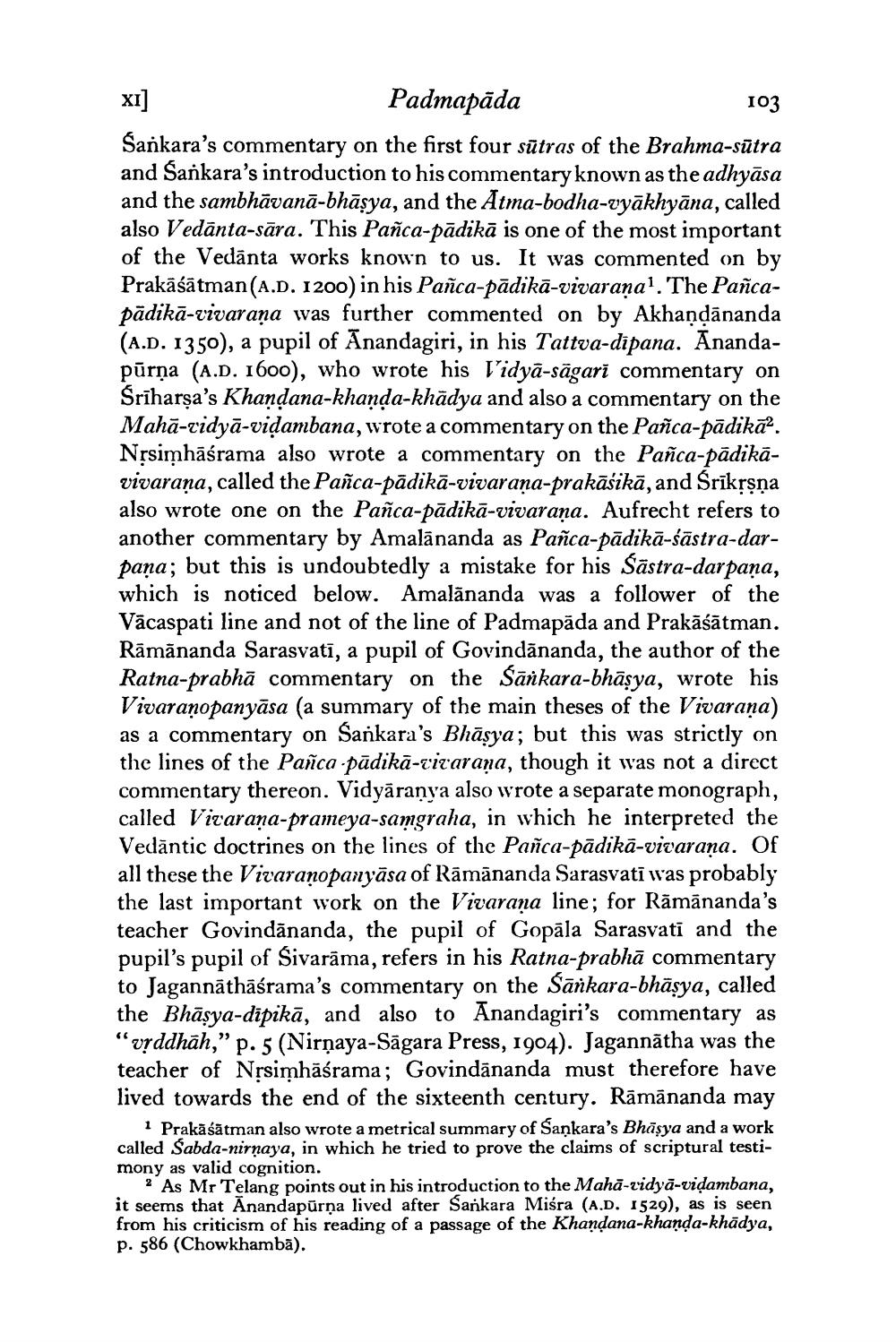________________
XI] Padmapāda
103 Sankara's commentary on the first four sūtras of the Brahma-sūtra and Sankara's introduction to his commentary known as the adhyāsa and the sambhāvanā-bhāşya, and the Atma-bodha-vyākhyāna, called also Vedānta-sāra. This Pañca-pādikā is one of the most important of the Vedānta works known to us. It was commented on by Prakāśātman(A.D. 1200) in his Pañca-pādikā-vivarañal. The Pañcapädikā-vivarana was further commented on by Akhandānanda (A.D. 1350), a pupil of Anandagiri, in his Tattva-dipana. Anandapūrna (A.D. 1600), who wrote his l'idyā-sāgari commentary on Śrīharşa's Khandana-khanda-khādya and also a commentary on the Mahā-vidyā-vidambana, wrote a commentary on the Pañca-pādikā”. Nysimhāśrama also wrote a commentary on the Pañca-pādikāvivaraṇa, called the Pañca-pādikā-vivarana-prakāśikā, and Śrīkrsna also wrote one on the Pañca-pādikā-vivarana. Aufrecht refers to another commentary by Amalānanda as Pañca-pādikā-śāstra-darpaņa; but this is undoubtedly a mistake for his Šāstra-darpaņa, which is noticed below. Amalānanda was a follower of the Vācaspati line and not of the line of Padmapāda and Prakāśātman. Rāmānanda Sarasvatī, a pupil of Govindānanda, the author of the Ratna-prabhā commentary on the Sankara-bhāșya, wrote his Vivaranopanyāsa (a summary of the main theses of the Vivarana) as a commentary on Sankara's Bhāsya; but this was strictly on the lines of the Pasca-pādikā-viraraṇa, though it was not a direct commentary thereon. Vidyāraṇya also wrote a separate monograph, called Vivarana-prameya-samgraha, in which he interpreted the Vedāntic doctrines on the lines of the Pañca-pādikā-vivarana. Of all these the Vivaranoparyāsa of Rāmānanda Sarasvati was probably the last important work on the Vivarana line; for Rāmānanda's teacher Govindānanda, the pupil of Gopāla Sarasvati and the pupil's pupil of Sivarāma, refers in his Ratna-prabhā commentary to Jagannāthāśrama's commentary on the Sārkara-bhāsya, called the Bhāsya-dīpikā, and also to Anandagiri's commentary as "vrddhāh," p. 5 (Nirņaya-Sāgara Press, 1904). Jagannātha was the teacher of Nộsimhāśrama; Govindānanda must therefore have lived towards the end of the sixteenth century. Rāmānanda may
i Prakāśātman also wrote a metrical summary of Sankara's Bhāsya and a work called Sabda-nirnaya, in which he tried to prove the claims of scriptural testimony as valid cognition.
? As Mr Telang points out in his introduction to the Mahā-vidyā-vidambana, it seems that Anandapūrņa lived after Sarkara Miśra (A.D. 1529), as is seen from his criticism of his reading of a passage of the Khandana-khanda-khādya, p. 586 (Chowkhambā).




